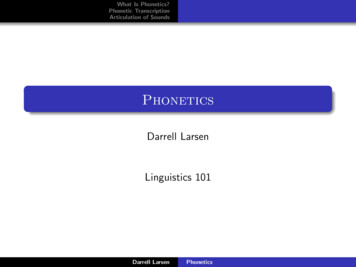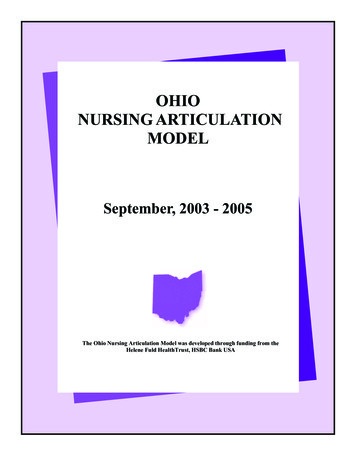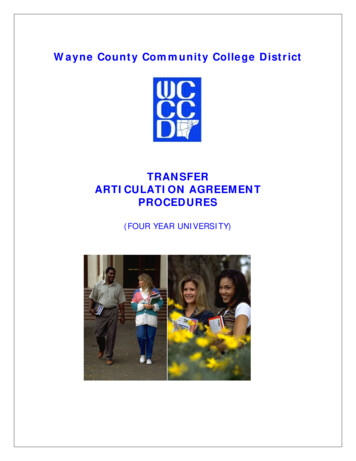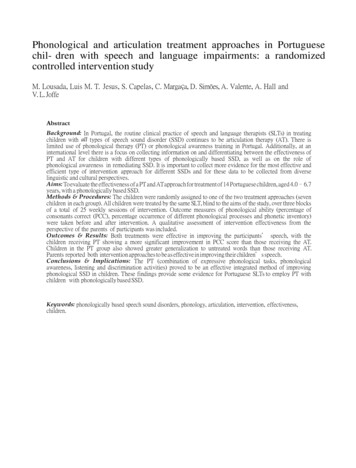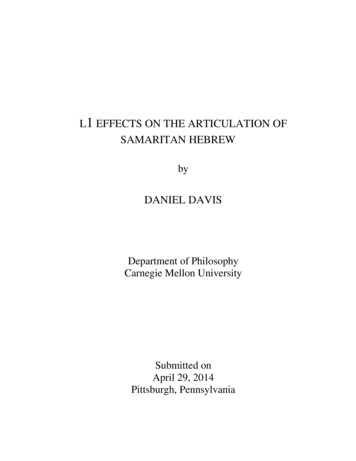
Transcription
L1 EFFECTS ON THE ARTICULATION OFSAMARITAN HEBREWbyDANIEL DAVISDepartment of PhilosophyCarnegie Mellon UniversitySubmitted onApril 29, 2014Pittsburgh, Pennsylvania
iiAcknowledgementsI would never have been able to write this thesis without the assistance of the manypeople who helped me along the way. First and foremost among them is Professor Tom Werner,my adviser both for this thesis and the linguistics major at Carnegie Mellon University (CMU),who committed an unbelievable amount of time to helping me realize this work. This neverwould have been written without him, and I owe him a great deal.I'd also like to thank everyone who helped fund this project. Specifically, Professor Ackerof the History Department, Professor Polansky of the Modern Languages Department, ProfessorSkinner of the Center for International Relations and Politics, and the Undergraduate ResearchOffice, all of CMU, contributed generously. I'd like to thank Professor Scheines of thePhilosophy Department at CMU in particular, who stepped in when it seemed as though I wouldhave insufficient funding and covered the difference.When it became clear that I would indeed be able to travel to the Middle East, it becamenecessary to quickly obtain Institutional Review Board approval, a process for which I had littletime. Professor David Danks, head of the IRB at CMU, went well beyond what would have beenexpected in guiding me through the process and ensuring that it would be completed in a timelymanner. Without his help, I would have arrived without being able to complete my research.I have received a great deal of academic support in completing this project as well.Professor Mandy Simons of the CMU Philosophy Department, Professor Steven Fassberg of theHebrew University of Jerusalem, and Professors Abraham Tal and Moshe Florentin of Tel AvivUniversity all took time to guide me. I would like to thank Professor David Mortensen of theUniversity of Pittsburgh in particular, for serving as an additional reader of the first draft of thiswork and providing me with valuable insight into how to conduct linguistic field work.The most exciting part of working on this thesis was in working with my informants, andso I would also like to thank the Samaritans who spent a considerable amount of time workingwith me and inviting me into their homes. I was overwhelmed with the welcome I received whenI came to the Middle East, and will not soon forget the time I spent acquiring my data.Finally, I would like to thank the participants of the Dietrich Undergraduate Colloquiumat CMU and the Seventh Toronto Undergraduate Linguistics Conference at the University ofToronto for attending my presentations and providing me with valuable feedback.
iiiContentsIntroduction.1Chapter 1 A Basic Overview of Samaritan Hebrew.31.1 - Genetic Relations and Orthography.31.2 - Phonology.41.2.1 - Consonant Phonemes.41.2.2 - Vowels Phonemes.61.3 - Morphosyntax.6Chapter 2 Semitic Languages.72.1 - Semitic Linguistics and the Genetic Relation of Language.72.1.1 - The Extent of Linguistic Familial Relation.72.1.2 - Proto-languages and Glottochronology.82.1.3 - Proto-Semitic Dating.82.1.4 - Semitic Consonant Phonology.92.1.5 - Other Features of Semitic Linguistics.102.2 - A History of Semitic Speakers and Language Change.112.2.1 - Ancient Civilizations and the Development of Written Language.112.2.2 - The Rise and Fall of the Israelite Kingdoms.132.2.3 - The Babylonian Exile and the Construction of the Second Temple.152.2.4 - Rome and the Loss of Jerusalem.172.2.5 - The Rise of Islam and Arabic.182.2.6 - The Jewish Exile, Zionism, and Modern Hebrew.19Chapter 3 Who Are the Samaritans?.233.1 - Origins.243.1.1 - The Samaritan Tradition.253.1.2 - The Jewish Tradition.263.2 - The History of the Samaritans.263.2.1 - The End of the Babylonian Exile.273.2.2 - The Seleucids and the Maccabees.273.2.3 - Rome.283.2.4 - After Rome.28
iv3.2.5 - The State of Israel.303.3 - The Samaritans Today.31Chapter 4 Data Analysis.324.1 - Methodology for Data Collection.324.2 - Results.334.2.1 - Samaritan Hebrew Vowels.334.2.2 - General Comments.344.2.3 - Data.354.3 - Discussion.414.3.1 - Emphatics.414.3.2 - Aspiration.424.3.3 - Voice Onset Time (VOT) of Voiced Stops.434.3.4 - Rhotics.444.3.5 - Gutturals.444.3.6 - Fricatization of ב and Modern Hebrew Stop/Fricative Allophony.454.3.7 - Allophony of Samaritan Hebrew ל .464.4 - Conclusions and Future Directions.464.4.1 - Parameters for Further Study.464.4.2 - The Nature of the Phoneme in Liturgical Languages.474.4.3 - A Warning Regarding Future Studies in Samaritan Hebrew.48References.49Appendix.51A1 - A Brief Introduction to Linguistics.51A2 - Corresponding Semitic Letters in Hebrew, Aramaic, Samaritan, and Arabic.52A3 - A Comparison of the Jewish and Samaritan Versions of the Pentateuch.53A4 - Matres Lectionis.54A5 - The Afroasiatic Language Phylum [Chart].55A6 - Semitic Roots.56A7 - Semitic Templates.57A8 - A Map of Ancient Civilizations in the Middle East.58A9 - Elicitation Materials - Nonce Words.59A10 - Elicitation Materials - Words.60
1IntroductionIn this thesis, I will discuss the effects of the linguistic divide in the Samaritancommunity with respect to the articulation of the liturgical language of Samaritan Hebrew.I first encountered the Samaritans in 2010 while on my first visit to the Palestinian city ofNablus. I had been to Israel many times prior, yet as a young Jewish American, I had neverbefore had the opportunity to travel to the Palestinian Territories. Given the prominence of thepolitical situation, I originally set out with no other goal in mind then to learn of the effects of theongoing Israeli-Palestinian conflict on those living in the West Bank.Prior to that first visit, I had only ever heard of the Samaritans tangentially, and wastherefore very surprised to learn of the community on Mount Gerizim. I spent only an afternoonin the Samaritan village yet learned not just how they have been affected by the conflict, but alsoof their history and traditions. The Samaritans left such an impression on me that, when the timecame four years later to determine a topic for my undergraduate thesis, I remembered this visit,and recalling its original purpose, decided to explore yet another facet of the conflict - namely,how it has indirectly affected the linguistic heritage of the Samaritan tradition.The modern Samaritan community survives in two groups, one in Israel and one in thePalestinian Territories. While all Samaritans share a common heritage, which includes the use ofunique forms of Ancient Hebrew and Aramaic for religious purposes, Israeli Samaritans speakModern Hebrew as their first language while Palestinian Samaritans use Palestinian Arabic.For what is today such a small community, it is striking how much scholarship alreadyexists relating both to the Samaritans and their linguistic tradition, not to mention scholarshiprelating to Semitic languages in general. However, the specific question I raise here has notpreviously been studied as it doesn't really contribute to the study of historical Semiticlinguistics, the usual interest of those who study the Samaritan languages. Indeed, Ze'ev BenHayyim (2000: 30), the Israeli linguist who completed the first comprehensive review of theSamaritan linguistic tradition, clearly states in his seminal work that he generally prefers the useof broad transcription that ignores variation between speakers and communities, as "thepresenting of the precise phonetic values of these sounds is rather a matter of the Samaritancommunities' vernacular.". While such a decision is perfectly appropriate for a grammar ofSamaritan Hebrew, I have chosen to focus specifically on these differences.
2To accomplish this task, I rely on the research that I completed over the 2013-2014 NewYear in Israel and the Palestinian Territories, where I recorded Samaritans reading select wordsin Samaritan Hebrew. However, for my findings to mean anything, a baseline for comparison isnecessary; I will therefore begin by reviewing Samaritan Hebrew phonology as it is understoodbroadly in the literature (section 1). Additionally, in order to distinguish what differences can beattributed to recent influence versus historical change, I will provide a linguistic history ofHebrew and Arabic (section 2) as well as a history of Samaritan Hebrew and the Samaritans(section 3). I will then conclude with a presentation of my findings, and the conclusions that canbe drawn from them (section 4). For those readers who are unfamiliar with linguistic theory andterminology but who are nonetheless interested in the topic, I provide some descriptions in thebody of the text in addition to basic introductory material in the appendix (P.51).Given the focus of this thesis, it is impossible to cover every topic I touch upon in detail;I therefore refer to works throughout which the reader may use to learn more. It is my hope thatthis work will provide a valuable contribution to this body of work by offering a new perspectiveon a language and community that has already been studied intensely, and that it may promptfurther study into a topic of which I have only scratched the surface.
31 - A Basic Overview of Samaritan HebrewThis section will provide a basic overview of Samaritan Hebrew, with a focus onphonology. This information is necessary to establish a baseline with which to compare thenarrow transcription data which I have collected, and will be referred to frequently throughoutthe remainder of this work. Note that all discussion of Samaritan Hebrew in this section relates tothe language as it is currently used; historical changes will be discussed later on.I rely on the work of Ze'ev Ben-Hayyim in this section, specifically, the English versionof his seminal work "A Grammar of Samaritan Hebrew: Based on the Recitation of the Law inComparison with the Tiberian and Other Jewish Traditions" (2000). For those who are interestedin learning more about Samaritan phonology or in studying other aspects of Samaritan Hebrew,this would be the best place to start. For a more thorough review of the historical development ofSamaritan grammar over time, something which I do not provide here, refer to Florentin (2005).1.1 - GENETIC RELATIONS AND ORTHOGRAPHYSamaritan Hebrew is an ancient Semitic language which has not been spoken as a secularlanguage since the Second Temple Period. It shares many similarities with Ancient Hebrew - aterm which I will attempt to precisely define later on - and the various Jewish traditions of thatliturgical language, and in many ways can be compared to modern Semitic languages likePalestinian Arabic and Modern Hebrew. Like many Semitic languages, written SamaritanHebrew is abjadic, meaning that consonants carry significantly more "weight" in conveyingmeaning, while vowels are not represented in writing.Given the direct genetic relation to Ancient Hebrew, it should be unsurprising thatSamaritan Hebrew also has 22 letters, with a one-to-one correspondence with all other Hebrewdialects. As such, I will use the Modern Hebrew alphabet in representing all Samaritan Hebrewtext under analysis. However, it is important to remember that the orthographies of the languagesdiverge; a display of the current Samaritan Hebrew alphabet can be found in the appendix (P.52).Note that, unlike Modern Hebrew, Samaritan Hebrew does not have final letters, a feature whichwill be discussed in section 2.
4It is worth noting briefly that the actual spelling of words in Samaritan Hebrew isextremely similar to that of Ancient Hebrew, to the extent that the Samaritan version of thePentateuch is fully intelligible to someone versed in Samaritan orthography and capable ofunderstanding the Jewish versions. There are a number of publications which highlight thedifferences between the two versions, as these are of significant interest to religious scholars; anexample page representing both Jewish and Samaritan traditions in Modern Hebrew typeset canbe found in the appendix (P.53) (Tsedaka & Tsedaka 1961: 1).1.2 - PHONOLOGYThe phonology of Samaritan Hebrew is likely what sets it apart most notably from otherSemitic languages in general and Hebrew in particular. Note that I will focus almost exclusivelyon analyzing the consonant phonemes of the language, and will only give a cursory review of thevowels. I have several reasons for doing so, which I will discuss in greater detail later.1.2.1 - CONSONANT PHONEMESThroughout this work, both in the case of Samaritan Hebrew as well as Modern Hebrewand Arabic, I will treat each letter of the Semitic alphabet as a separate phoneme, unlessotherwise noted. This is a simplistic form of the treatment used by Ben-Hayyim and, thoughperhaps at times an inaccurate portrayal of Modern Hebrew due to phonemic merger, is still themost convenient and useful for the purposes of comparative analysis.Table 1 provides the phonemic inventory of Samaritan Hebrew, and integrates theSemitic letters representing the phonemes into the chart alongside the International PhoneticAlphabet (IPA) symbols:
5BilabialLabiodentalDentalt/ ת Stop (vl.)Stop (vd.)b/ ב d/ ד Nasal Stopm/ מ n/ נ DentalPost-(velarized)alveolarPalataltɣ/ ט VelarUvulark/ כ q/ ק g/ ג r/ ר Trillf/ פ Fricative (vl.)ʃ/ ש w*/ ו l/ ל Lateralsɣ/ צ z/ ז Fricative (vd.)Approximants/ ס j/ י ApproximantTABLE 1.Distribution of the phonemes of Samaritan Hebrew (Ben-Hayyim 2000: 31)*Note: By convention, /w/ is a velarized bilabial approximantNote that, while I have relied on Ben-Hayyim's analysis, I have changed hisrepresentation so as to be more in line with current linguistic terminology. I have also changedthe phonetic symbols representing the sounds to be more in line with the IPA.Also note that I have intentionally excluded four letters from the chart, namely: ע , ח , ה , א .These letters each represented distinct phonemes historically (for more information, see section2). However, their realization in Samaritan Hebrew is not so straightforward. Ben-Hayyimnominally treats א and ע as distinct phonemes (a glottal stop and voiced pharyngeal fricative,respectively), while ה and ח are considered to have merged into these to a certain extent (2000:38). While a more thorough treatment would provide a better explanation of the realization ofthese four letters in different contexts, I instead choose to classify them here as "gutturals," asBen-Hayyim himself chooses to do on occasion, and exclude them from the chart above simplydue to uncertainty as to where to place them (historically, and throughout Semitic language,these four letters tend to represent the four phonemes whose place of articulation is behind theuvula). The fact that these four letters can, in some cases, act as matres lectionis (for a definition,specifically pertaining to Ancient Hebrew, refer to my Biblical Hebrew notes (2014) in theappendix (P.54)) further complicates the matter. Treatment of these consonants in this way doesnot influence data analysis (see section 4), and is therefore appropriate for use in this work.
6According to Ben-Hayyim, the letter ו has undergone significant change over the years,resulting in a somewhat confusing distribution in the current tradition. In addition to the typical[w], it appears as though this letter can also be realized as [b]. The processes that led to this aresomewhat complex, and it appears as though the realization of the letter as [b] is not phonemic,but morphologically or lexically driven. Again, I will not attempt to narrow down the descriptionof this letter further here, as it will not impact data analysis (2000: 33-34).Finally, the only letter believed to exhibit consistent allophonic variation across speakersis ל , where /l/- [l], [lɣ]. This is apparently a development that took place independently inSamaritan Hebrew (Ben-Hayyim 2000: 38).1.2.2 - VOWELS PHONEMESSamaritan Hebrew has five vowel phonemes, according to Ben-Hayyim: /i/, /e/, /a/, /ɒ/,and /o,u/, where the underlying form of the last is uncertain. Again, I have changed hisrepresentation of these vowels to modern IPA based on the provided description. Thesephonemes are realized differently depending on the environment and the care and speed of thereader, with as many as four distinctions in vowel length simultaneously affecting vowel quality(2000: 43-46).1.3 - MORPHOSYNTAXSamaritan Hebrew is very similar to Ancient Hebrew morphosyntactically. Like Hebrew,it is morphologically templatic (for a description of Semitic templatic structure, refer to 2.1.5),and recognizes the same group of seven "core" templates and several "exotic" ones, as doesAncient Hebrew (none of this should be surprising, as the texts which convey both linguistictraditions are very similar to each other). It also recognizes the same group of tenses/aspect (thedifference of which I will not comment on further, as it is not pertinent to my thesis). However,there are several minor inflectional differences - for example, the conjugative endings for verbsin the perfect/past in 1st and 3rd singular are identically /-ti/, distinguished from the AncientHebrew /-ti/ and /-t/, respectively (2000: 101-103).
72 - The Semitic LanguagesThis section will provide a background of the Semitic languages in general and anoverview of the historical influences that have contributed to their change over time.Understanding the Semitic languages as a whole is necessary for understanding how SamaritanHebrew developed. In addition, there are many linguistic features that Samaritan Hebrew shareswith other Semitic languages, and only by understanding these features broadly is it possible totrack these changes as I will in section 4.2.1 - SEMITIC LINGUISTICS AND THE GENETIC RELATION OF LANGUAGE2.1.1 - THE EXTENT OF LINGUISTIC FAMILIAL RELATIONOne of the most fundamentally important concepts in modern linguistics is that of geneticrelation between languages. This idea has been nominally understood for millennia - there is nodoubt that European scholars of the Middle Ages were well aware that the Romance languages,such as Spanish, French, and Italian, both developed from a common Latin source. However, theextent to which relations between languages were possible was not truly realized until the late18th century, when scholars discovered the similarities between Greek, Latin, and Sanskrit andproposed the existence of the now commonly accepted Indo-European language family.In the same vein, the similarities between Hebrew and Arabic are extremely obvious toanyone who is at least partially familiar with the two languages, and the concept of a Semiticlanguage family has been accepted for a long time. However, it is commonly believed that, muchlike the Romance language family, the Semitic language family belongs to a broader group oflanguages. That group is today known as the Afroasiatic language family (or phylum, suggestinga grouping of traditional language families). For a detailed chart relating the Semitic languagesto each other and the broader phylum, refer to the appendix (P.55).A discussion of the typographical features of the phylum and the techniques used toconfirm it is beyond the scope of this thesis - for more information, refer to Diakonoff (1988) orFrajzyngier and Shay (2012). However, one feature of this relational theory will help us to betterunderstand the Semitic language family, and that is the concept of the proto-language.
82.1.2 - PROTO-LANGUAGES AND GLOTTOCHRONOLOGYLinguistic theory has demonstrated that, just as French, Italian, and dozens more have acommon source in Vulgar Latin, so too must Hebrew, Arabic, Maltese, and all the rest have asingle common source (note that this does not prevent influence from other languages orlanguage families). We generally refer to such source languages as "proto-languages" - everysingle language family, by definition, must have one. In some cases, these proto-languages areknown, as is (effectively) the case of Latin. However, many of these languages died well beforewritten language and recorded history, and so various techniques have been developed toreconstruct these languages based on data from all available source languages. There are alsoways to combine statistical models with this reconstruction process to provide approximate datesfor the point at which languages diverged from these common sources; this is, more or less, thefield of glottochronology. While these methodologies have come under criticism and mayprovide results that are not completely reliable, they are nonetheless a useful tool inunderstanding language development over time; glottochronological data is therefore presentedin this paper with the understanding that the values may not necessarily be fully accurate.2.1.3 - PROTO-SEMITIC DATINGWork by Militarev (2000) provides a glottochronological overview of the Afroasiaticphylum. This work shows that the original source for the entire phylum, proto-Afroasiatic, splitaround the year 10,000 BCE, yielding six further proto-languages (though the inclusion ofOmotic is disputed). Proto-Semitic, one of these six, developed over the course of severalmillennia, and is confirmed to have itself split around the year 4,300 BCE. This is the point atwhich the Semitic language family was born, and the intervening 6,000 years have left ampletime for linguistic change and language death. Additional glottochronological information isprovided on the aforementioned chart, found in the appendix (P.55). It will be beneficial to referback to this chart over the course of this section, so as to have a better understanding of howthese various languages are related and how they have influenced each other's development.
92.1.4 - SEMITIC CONSONANT PHONOLOGYWhile there is disagreement regarding the phonological nature of proto-Semitic, there aremany generalizations that can be drawn from the source languages and that will assist us in betterunderstanding the family. For additional information, refer to either Hetzron (1997) orFrajzyngier and Shay (2012: 153-159).It is believed that proto-Semitic had a total of 29 consonant phonemes. The approximateinventory in Table 2 below is disputed, but is realistically as close as possible given that it is areconstruction. Again, some terminology has been changed:BilabialInterdentalDentalPalatalVelarStop (vl.)ptkStop (vd.)bdgtʼkʼStop (em.)Nasal StopmPharyngealGlottalʔnrTrillFricative (vl.)θsFricative (vd.)ðzFricative (em.)θʼsʼçxħɣʕhLateralFricative (vl.)LateralFricative (em.)ɬLateralFricative (vl.)ɬʼLateralFricative (em.)ApproximantLateralw*jlApproximantTABLE 2.Distribution of the phonemes of proto-Semitic (Frajzyngier & Shay 2012:153)*Note: By convention, /w/ is a velarized bilabial approximant
10One historical feature of the Semitic languages that likely goes all the way back to theprotolanguage is the existence of a class of sounds known as the "emphatics," seen above. Thesewere (and are, in modern languages) a class of sounds which each had a non-emphatic voicelesscounterpart. While these sounds have, generally speaking, patterned together in all Semiticlanguages, different modern languages realize them differently, and so it is impossible toascertain exactly what their character was in proto-Semitic. In most Arabic dialects, they usuallyhave a secondary articulatory feature of pharyngealization (Frajzyngier & Shay 2012: 153).An unusual feature of proto-Semitic is the presence of pharyngeals in its phonemicinventory. These sounds are very uncommon and were not retained in many Semitic languages,with the notable exception of Arabic.Another uncommon set of phonemes that are believed to have been present in protoSemitic are the voiceless and emphatic lateral fricatives /ɬ/ and /ɬʼ/. Again, these sounds seem tobe less preferred in natural language, and were lost in virtually all descendant languages. Themanner in which they were lost in Hebrew is discussed in greater detail below.2.1.5 - OTHER FEATURES OF SEMITIC LINGUISTICSAlthough it has relatively little bearing on the data collected, I will provide a very briefdescription of some other common features of Semitic languages.Proto-Semitic is believed to have had a canonical three-vowel inventory, with anadditional length distinction; that is to say, it had the phonemes /i/, /a/, /u/, /iː/, /aː/, /uː/. It alsohad two diphthong phonemes: /aj/ and /aw/. Some languages retained this basic inventory, whileothers changed it significantly (Frajzyngier & Shay 2012: 160).All Semitic languages have a two-way distinction for grammatical gender, in which allnouns, animate and inanimate, are assigned one or the other, seemingly arbitrarily (Frajzyngier &Shay 2012: 168). In at least a few cases, a single noun can have variable gender, though this israre (Lambdin 1971: 4). Many of the older Semitic languages also originally had a three-waydistinction for number, including singular, dual, and plural, though
Hebrew is abjadic, meaning that consonants carry significantly more "weight" in conveying meaning, while vowels are not represented in writing. Given the direct genetic relation to Ancient Hebrew, it should be unsurprising that Samaritan Hebrew also has 22 letters, with a one-to-one correspondence with all other Hebrew dialects.



